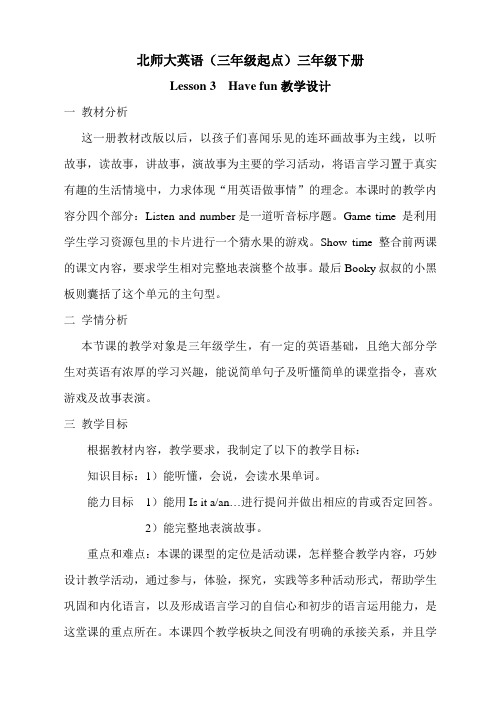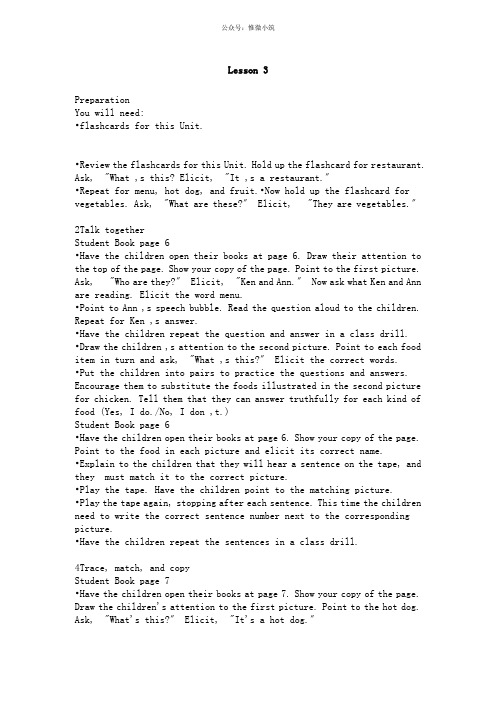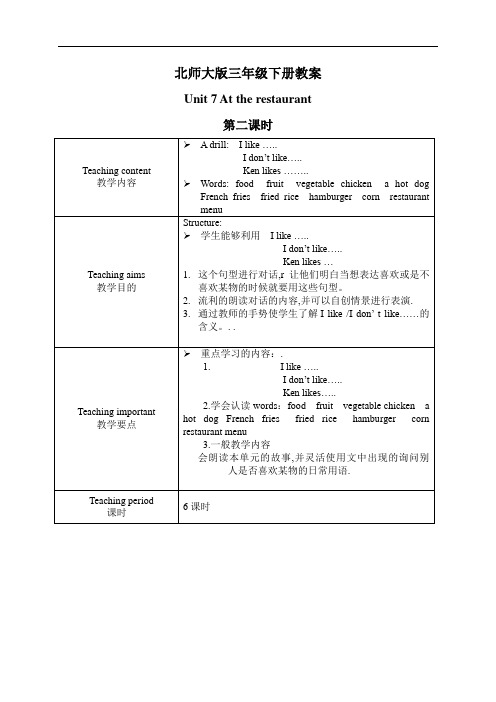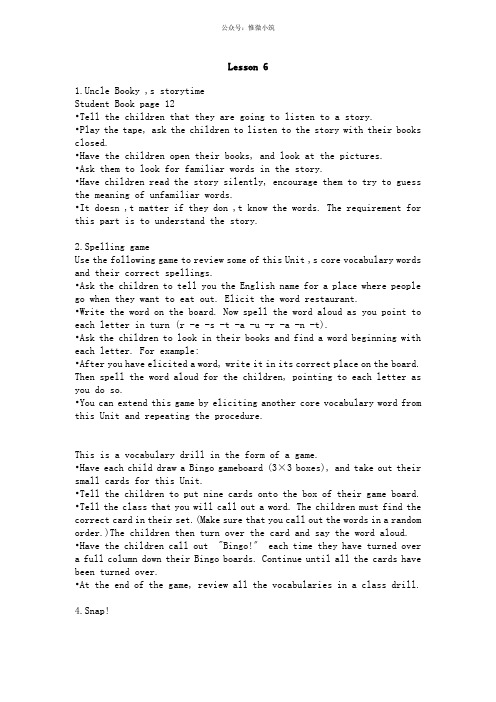三年级英语下册 unit7 Lesson3教案 北师大版
- 格式:doc
- 大小:24.50 KB
- 文档页数:1

北师大英语(三年级起点)三年级下册Lesson 3 Have fun教学设计一教材分析这一册教材改版以后,以孩子们喜闻乐见的连环画故事为主线,以听故事,读故事,讲故事,演故事为主要的学习活动,将语言学习置于真实有趣的生活情境中,力求体现“用英语做事情”的理念。
本课时的教学内容分四个部分:Listen and number是一道听音标序题。
Game time 是利用学生学习资源包里的卡片进行一个猜水果的游戏。
Show time 整合前两课的课文内容,要求学生相对完整地表演整个故事。
最后Booky叔叔的小黑板则囊括了这个单元的主句型。
二学情分析本节课的教学对象是三年级学生,有一定的英语基础,且绝大部分学生对英语有浓厚的学习兴趣,能说简单句子及听懂简单的课堂指令,喜欢游戏及故事表演。
三教学目标根据教材内容,教学要求,我制定了以下的教学目标:知识目标:1)能听懂,会说,会读水果单词。
能力目标1)能用Is it a/an…进行提问并做出相应的肯或否定回答。
2)能完整地表演故事。
重点和难点:本课的课型的定位是活动课,怎样整合教学内容,巧妙设计教学活动,通过参与,体验,探究,实践等多种活动形式,帮助学生巩固和内化语言,以及形成语言学习的自信心和初步的语言运用能力,是这堂课的重点所在。
本课四个教学板块之间没有明确的承接关系,并且学生也没有可供活动使用的资源卡片,怎样整合教材,流畅地设计有效的教学活动是本课的难点。
四教学准备多媒体水果实物水果卡片等五教学流程模式结构教学步骤教师活动学生活动设计意图一、热身1 Greeting.2 sing asong.<Mom,Mom,dear Mom>3 Chant.<Is it anorange?>1 Greeting.2 sing.3 chant1 Greeting.2 sing3 chant师生互致问候,营造良好气氛.师和生唱歌,有韵律的背歌谣,活跃课堂气氛,歌谣中出现的主句型为课堂活动的开展做铺垫。

(北师大版)三年级英语下册教案Unit7Unit 7 At the restaurantThe first periodWords: smart, what’s, name, birdDialogues:Good morning. I’m Ms Smart.What’s your name?一、教学目标1、听懂、会说、初步能认读:chicken,vegetables,noodles,fruit,能理解:restaurant.听懂、会说、初步能认读:Do you like……?Yes, I do. / No, I don’t.听懂、会说What do you like…?I like….I don’t like ….2、能比较熟练地应用所学的语言知识进行初步交际。
3、把语言训练融于各种情景及活动中,营造一种轻松愉快的教学氛围,促进学生充满乐趣地学习,并在活动中学会合作。
二、教材分析本课是北师大版《小学英语》(一年级起点)三年级下册Unit 7第一课。
本课的教学内容是童话故事,整个故事包含本单元的核心单词和句型。
其故事情节是活泼可爱的小动物Mocky和Ann及她的家人在餐厅里发生的事,并配有生动活泼、富有情趣的插图,其旨在有意义的语言环境中呈现新知,感受新知并运用新知。
根据《英语新课程标准》精神,结合学生的身心特点及英语基础,本课主要采用情景教学法、活动教学法以及任务型教学,创设生动、真实的语言环境,意义呈现,意义训练,学用结合。
通过猜谜、唱歌等,把书本知识融进各种活动中,让学生在活动中不断吸收,内化所学的语言材料。
但由于本课新词较多,对某些接受能力差的学生而言,有点困难。
因此,我在设计时,先用句型I like…/I don’t like….教学三个单词chicken,vegetables,noodles,然后将page 11的chant 提前于此对上述内容加以巩固,再教学fruit和Do you like…及其回答。

Lesson 3PreparationYou will need:•flashcards for this Unit.•Review the flashcards for this Unit. Hold up the flashcard for restaurant. Ask, "What ,s this? Elicit, "It ,s a restaurant.〞•Repeat for menu, hot dog, and fruit.•Now hold up the flashcard for vegetables. Ask, "What are these?〞 Elicit, "They are vegetables.〞2Talk togetherStudent Book page 6•Have the children open their books at page 6. Draw their attention to the top of the page. Show your copy of the page. Point to the first picture. Ask, "Who are they?〞 Elicit, "Ken and Ann.〞 Now ask what Ken and Ann are reading. Elicit the word menu.•Point to Ann ,s speech bubble. Read the question aloud to the children. Repeat for Ken ,s answer.•Have the children repeat the question and answer in a class drill. •Draw the children ,s attention to the second picture. Point to each food item in turn and ask, "What ,s this?〞 Elicit the correct words.•Put the children into pairs to practice the questions and answers. Encourage them to substitute the foods illustrated in the second picture for chicken. Tell them that they can answer truthfully for each kind of food (Yes, I do./No, I don ,t.)Student Book page 6•Have the children open their books at page 6. Show your copy of the page. Point to the food in each picture and elicit its correct name. •Explain to the children that they will hear a sentence on the tape, and they must match it to the correct picture.•Play the tape. Have the children point to the matching picture.•Play the tape again, stopping after each sentence. This time the children need to write the correct sentence number next to the corresponding picture.•Have the children repeat the sentences in a class drill.4Trace, match, and copyStudent Book page 7•Have the children open their books at page 7. Show your copy of the page. Draw the children's attention to the first picture. Point to the hot dog. Ask, "What's this?〞 Elicit, "It's a hot dog.〞•Now point to Ann's speech bubble and read the words to the children. Have them repeat the words after you. Ask the children which word is missing. They should answer, "Hot dogs.〞•Have the children find the correct word in the box and trace it. Then have them copy the word in the space provided to complete the sentence. •Repeat the procedure for the other pictures and words.•Check that all the children have completed the sentences correctly.5Set homeworkStudent Book page 6Tell the children to color the pictures on the page.。

三年级英语下册教案UNIT SEVEN I WANT TO BE A TEACHER 北京版教学内容本单元的主题是“我想成为一名教师”,主要围绕职业梦想展开。
教学内容包括职业名称的英语表达,例如“teacher”、“doctor”、“driver”等,以及表达个人职业愿望的句型“I want to be a”。
还涉及到简单的职业描述和理由表达,如“Because”。
教学目标1. 知识目标:学生能够听懂、会说、会读本单元的关键词汇和句型。
2. 能力目标:学生能够运用所学句型和词汇表达自己的职业愿望,并能简单陈述理由。
3. 情感目标:培养学生对不同职业的尊重和认识,激发他们对未来的积极期待和规划。
教学难点1. 正确发音和记忆职业名称的英语词汇。
2. 构建并运用“I want to be a Because”的句型结构。
3. 自然、流畅地进行职业愿望的口语表达。
教具学具准备1. 教学卡片:展示不同职业的图片和对应英语单词。
2. 视频材料:展示不同职业的工作场景。
3. 角色扮演道具:模拟不同职业的服装或工具。
教学过程1. 导入:通过展示不同职业的图片,引导学生复习已知的职业名称,并引入新职业的学习。
2. 新授:使用教学卡片和视频材料,教授新职业的英语表达,让学生跟读并模仿。
3. 实践:设计角色扮演活动,让学生分组练习表达自己的职业愿望。
4. 巩固:通过小组竞赛,鼓励学生运用所学句型和词汇。
板书设计板书将清晰地展示本节课的主要教学内容,包括职业名称的词汇表和“I want to be a Because”的句型结构。
同时,板书上还将附有相关的图片,以增强视觉效果和记忆联系。
作业设计1. 书面作业:完成课后练习册中与本单元相关的练习题。
2. 口头作业:向家长介绍自己想成为的职业,并说明原因。
课后反思课后反思将围绕学生的参与度、教学内容的掌握情况以及教学方法的适应性进行。
教师需根据学生的反馈和学习效果,调整教学策略,以便更好地满足学生的学习需求,并促进他们对未来职业的思考和规划。


Lesson 61.Uncle Booky ,s storytimeStudent Book page 12•Tell the children that they are going to listen to a story.•Play the tape, ask the children to listen to the story with their books closed.•Have the children open their books, and look at the pictures.•Ask them to look for familiar words in the story.•Have children read the story silently, encourage them to try to guess the meaning of unfamiliar words.•It doesn ,t matter if they don ,t know the words. The requirement for this part is to understand the story.2.Spelling gameUse the following game to review some of this Unit ,s core vocabulary words and their correct spellings.•Ask the children to tell you the English name for a place where people go when they want to eat out. Elicit the word restaurant.•Write the word on the board. Now spell the word aloud as you point to each letter in turn (r -e -s -t -a -u -r -a -n -t).•Ask the children to look in their books and find a word beginning with each letter. For example:•After you have elicited a word, write it in its correct place on the board. Then spell the word aloud for the children, pointing to each letter as you do so.•You can extend this game by eliciting another core vocabulary word from this Unit and repeating the procedure.This is a vocabulary drill in the form of a game.•Have each child draw a Bingo gameboard (3×3 boxes), and take out their small cards for this Unit.•Tell the children to put nine cards onto the box of their game board. •Tell the class that you will call out a word. The children must find the correct card in their set.(Make sure that you call out the words in a random order.)The children then turn over the card and say the word aloud. •Have the children call out "Bingo!〞 each time they have turned over a full column down their Bingo boards. Continue until all the cards have been turned over.•At the end of the game, review all the vocabularies in a class drill.4.Snap!This game reviews new vocabulary introduced in this Unit. It is best played in pairs.•Ask the children to take out their small flashcards for this Unit. •See previous unit, for the rules and procedure.-assessmentStudent Book page 13In self -assessment children need to assess themselves by their own so that they can have an idea of what they have achieved. Children can do this part by their own after class or the teacher can choose to assess the children within class time.•Ask the children to look at the pictures in the first activity. Ask if they know all of these food. Say, "I like vegetables.〞 "I don ,t like noodles.〞 Have children to work in pairs to talk about their preference of food with the help of the pictures. If necessary ask a confident pair to give one more example. At the end of the activity ask several pairs to check how well they could finish it.•In the second activity children need to finish the sentences. Say, "We are going to write out what we said just now.〞 Draw the children ,s attention to the sentences under the pictures. Tell them to finish the sentences. The children can read out their sentences and check in pairs.6.My notes and teacher ,s notesStudent Book page 13•This activity helps children have a look at what they have done in this Unit. Ask them to assess themselves according to the items in My Notes individually. Explain to them that the stars here only indicate how well they have done in their learning and the stars should not be changed to scores.•The teacher should evaluate the children positively in the part of Teacher ,s Notes. The purpose is to have children realize that they are making progress and to help them build up a sense of achievement and confidence. Stickers provided at the end of the Teacher ,s Resouce Book can be used here.7.Set homeworkStudent Book page 12Tell the children to read the story again with their parents.。
Unit7 Lesson3教学设计【内容来源】北师大三起点(2012年版)三下Unit7 Lesson3【主题】Have Fun.【课时】第3课时:Lesson3一、教学目标(Teaching aims)1. 能够在活动中运用水果类单词。
2. 能够分角色表演故事。
二、教学重难点(Teaching points and difficulties)(一)重点(Points)分角色表演故事。
(二)难点(Difficulties)在故事表演中把握正确的语音、语调。
(此难点为预设难点,教师可根据班里实际情况调整)三、教学准备(Teaching preparation)课件(教师可以在平台直接调用或下载),苹果、香蕉、桃、橘子、柠檬、草莓、菠萝、梨、西瓜图片。
四、教学过程Step 1: Warm-up1. 师生相互问候。
2. 教师播放Lesson2歌曲,学生跟唱。
Step 2:Presentation1. 复习单词及重点句型。
(1) 教师出示Part4图片,学生同桌之间进行对话;并找学生作为小老师带着大家读。
(2) 教师在课件上依次出示Lesson1 Part2和Lesson2 Part2水果类单词图片,师生间运用句型W hat’s this/that? It’s a/an …. Is it a/an …? Yes, it is./No, it isn’t.进行对话。
2. Part3: Show Time.(1) 教师分别播放Lesson1 Part1和Lesson2 Part1课文动画,学生跟读。
(提醒学生模仿录音中的语音、语调)(2) 教师分别出示Lesson1 Part1和Lesson2 Part1课文插图,学生配音(提醒学生模仿书中的表情、动作);挑四组学生上台表演。
(3) 教师出示Show Time图片,学生两人一组练习表演故事;挑五组学生上台表演。
Step 3: Practice1. Part1: Listen and Number.(1) 学生观察图片,同桌相互说出图片中单词。
Lesson 3 Have Fun教学目标1. 能分角色表演完整的故事;2. 能在活动中询问、说出水果的名称。
教学重点1. 朗读和表演完整的故事;2. 主要句型,如: What' s this? It' s. … Is it a…?Yes, it is. /No, it isn't .教具准备学生准备学习卡片。
教学过程Get Ready(1) 出示水果的图片,让学生说出这些水果的名称。
T: Now, look at the picture. What' s this?(2) 出示水果的单词卡片,让学生认读。
(3) 教师把水果的图片和单词卡片发给学生,让他们找到对应的伙伴。
可以在小组中组织“找朋友” 的游戏。
Listen and Number(1) 让学生看教材上的图,告诉学生接下来听录音、给图标序号。
,(2) 播放录音,学生边听边指相应的图。
(3) 再放一遍,让学生根据录音给图标序号。
(4) 放录音,每次一句,教师重复。
让学生说一说是哪一幅图,全班一起核对。
Game Time(1) 让学生看书上的图,告诉他们接下来玩一个看图、猜水果的游戏。
(2) 教师拿出一张卡片,挡住部分画面,让学生猜一猜是什么水果。
T: Look, what' s this?(3) 把学生分成小组,学生在小组中用学习卡片玩猜卡片的游戏。
(4) 也可以采用其他的猜卡片游戏,例如教师抽取一张水果的图片,放在一名学生头顶上,其他学生问,这名学生猜。
Ss: What' s this?S: Is it a pear?Show Time(1) 带着学生一起复习前两课的故事。
先放一遍故事动画,让学生认真观看,然后教师出示故事主要情节的插图,让学生回忆人物对话,复习故事。
(2) 让学生看书上的图,教师放录音,让学生指人物、跟读对话。
(3) 把学生分成四人一组练习表演故事。
可以利用教材提供的插图,也可以由学生自主选择表演的内容和方式。
北师大版三年级英语下册 Unit7 At restaurant教案内容(课题)Grade3 Unit7 At restaurant? 第1课时教学目标知识、技能过程、方法1、 Warm-up2、 Presentation3、 Extending listening4、 Using language情感、态度、价值观通过询问和表达对食物的爱好,鼓励学生大胆陈述自己的观点。
教学重点1、学习句型:Do you like …? Yes, I do./ No, I don’t.2、理解故事内容。
教学难点进一步体会功能句型的具体使用情境。
教学准备教师准备教材、多媒体课件学生准备教材教学用时教学方法教学过程教师活动学生活动备注1、Warm-up2、Presentation3、Extending listening4、Using languages板书设计Unit7 At the restaurant?Do you like …? Yes, I do./ No, I don’t. What do you like? I like …/ I don’t like …教学反思内容(课题)Grade3 Unit7 At the restaurant? 第2课时教学目标知识、技能过程、方法1、 Warm-up2、 Presentation3、 Listen to this4、Let’s sing5、 Extending listening情感、态度、价值观通过学习,激发认识,并通过本课的学习,增加学生对中餐和西餐中不同食物的认识,了解相关的文化知识。
教学重点学习食物名称:French fries, corn, fruit, vegetables, chicken, fried rice, noodles, a hamburger, a hot dog教学难点French fries和fried rice的学习。
教学准备教师准备教材、教学卡片、多媒体课件学生准备教材教学用时教学方法教学过程教师活动学生活动备注1、Warm-up2、Presentation3、Listen to this4、Let’s sing板书设计Unit7 At the restaurant!What food do you like? I like French fries corn fuit vegetables cicken fried rice nodles a hamburger ahot dog教学反思内容(课题)Grade3 Unit7 At the restaurant 第3课时教学目标知识、技能过程、方法1、 Warm-up2、 Presentation3、 Listen and number4、 Trace, match and copy情感、态度、价值观通过学习不同的描述和表达方式,培养学生运用观察、对比、归纳等方法学习的策略意见。
(北师大版)三年级英语下册教案Unit7
Unit 7 At the restaurant
The third period
一、教学目标与要求
能听懂、会说: Do you like grapes? No, I don't. I like bananas.并能根据自己的实际情况表达自己的心愿。
能听、说、读单词:corn, hamburger学英文歌曲:Do you like grapes?
二、教学重、难点分析重点:能听懂,会说:Do you like …?No, I don't. I like ….句型和生单词hamburger 和corn,
难点:能听懂,会说:将句型、对话与自己的实际情况结合起来。
能表达自己的心愿
三、课前准备
教师准备录音机、字母卡片。
四、教学步骤和建议
1. 热身
学生听录音表演以前所学的chant和英文歌曲。
全体同学齐读lesson1课,要求最齐、最快、最大声。
2、新授
学生跟读,教师纠正部分单词的发音。
学生分组分角色朗读,做到最快、最清晰、最大声试着请部分学生到前面表演对话,让学生为教学片配音用挂图或实物展示生词hamburger 和corn,然后清部分学生到教室前面边指边说.说的又快又好的同学将得到一朵小红花学习英文字母:学厂英文歌曲:Do you like grapes?
五、巩固与延伸
教师请部分同学用过去所学的同一类型的此来组织新的对话.
A: Hi Lucy, do you like apples.
B: No, I don't I like pears. What about you?
A: I like apples.
打开质量监测完成对应的练习(教师给予一定的指导)
家庭作业:跟读课文,认读字母、学唱英文歌曲, 能正确地说出自己喜欢什么,不喜欢什么.
用心爱心专心 1。